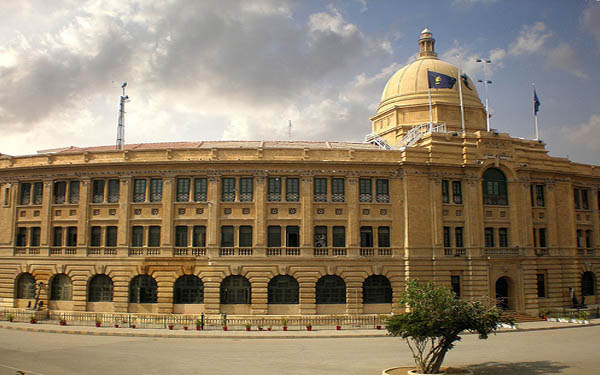

|
About KPT
|
| By 1852, Karachi was an established city with a population of about 14,000 with a prosperous trade in over-seas markets. However, the existing Port started taking shape in 1854, when the projects of dredging the main navigable channel and the construction of a mole or causeway joining the main harbor with the rest of the city were undertaken. About 5 years later, construction of Manora Breakwater, Keamari Groyne, the Napier Mole Bridge, Native Jetty and the Chinna Creek were started which gave initial shape to the port. Between 1880 and 1887, the port was administered by the Karachi Harbour Board. The Karachi Port Trust was then established by the Act IV of 1886, effective from 1 April 1887.
Karachi due to its geographical and strategic location is known as the gateway to Asia. Considered as a safe Harbor since time immemorial, Karachi was a small fishing village in early Nineteenth Century. The construction of the wharves started in 1882, and by 1914 the East Wharves and the Napier Mole Boat Wharf had been completed. During the period between 1927 and 1944, the West Wharves of the Port, the lighterage berths and the ship-repairing berths were constructed. Most of these facilities were obsolete by the time Pakistan came into existence in 1947. Since then, the port administration has embarked on extensive development of the port on modern lines. At the time of independence in 1947, the Port capacity was about 1.5 million tons of dry cargo and 1.0 million tons of P.O.L. products per annum. Karachi Port is now handling over 11.74 million tons of liquid cargo and 25.45 million tons of dry cargo, including 1,213,744 TEUs which constitute about 60% of import/ export of the country. The Karachi Port is administered by a Board of Trustees, comprising Chairman and 10 Trustees. The Chairman is appointed by the Federal Government and is also the Chief Executive of Karachi Port Trust. The remaining 10 Trustees are equally distributed between the public and the private sector. Port Facilities:
Karachi is a deep natural port with 11 KM long approach channel demarcated with buoys for providing safe navigation of 75, 000 DWT tankers, modern container vessels, bulk carriers and general cargo ships. The Port of Karachi provides the following facilities to vessels calling at the Port and to the Port Users Storage Facilities
Storage Facilities The port has 21 Sheds at the East wharf and 12 Sheds at the West wharf with a total covering area of 172,000 sq. meters. An open area of 234,000 sq. meters has been allocated to Container Parks at East and West Wharves. In addition to all this, KPT has a cotton yard known as TPX with a total area of 326,000 sq. meters out of which 136,000 sq. meters is covered and 190,000 sq. meters is open area. Statistic and Future Plans
Statistic and Future Plans During the years 1997-98 the port handled 22.6 metric tons of cargo as compared to 2.0 million metric tons of cargo handled during 1947-48. from the 22.6 million tons of cargo 13.1 million tons was liquid bulk cargo and 9.5 million tons was dry cargo. The Karachi Port also handled more than 505,000 TUES of Containers in 1997-98. It is estimated that cargo traffic will increase to 34 million tons of TEUS by the beginning of the 21st century. To cope with the increasing demand for cargo and container handling, KPT management has constructed a Liquid Products Marine Terminal OP-IV. This berth handles the crude and furnace oil imports and 50% of POL product and will increase the Liquid Cargo handling capacity of the port by 8 million tons. As the port is expected to handle 15 million tons of dry cargo and 1 million TEUS by the 21st century, the Port Management has allowed the private sector to construct an Integrated Container Terminal at Berths No. 14-17 at East wharf on a BOT (Build, Operate and Transfer) basis. The aim is to cope with the increased cargo and container handling demand. This Terminal will be capable of handling 350,000 TEUS of Containers annually. Another Container Terminal of the same capacity is to be constructed at West wharf on Berth No. 22-24. KPT has offered the Private sector to develop, all the berths at East and West Wharves as separate specialised terminals of 3 to 4 Berths each (i.e. Berths No. 1-4, Berths No. 5.8, Berths No. 2, Berths No. 18-20 etc, NMB Wharves Complex and Lighterage Berths Complex). To imporve and modernise cargo handling operations and to increase productivity and efficiency, the Private Sector has been invited to bring specialised cargo handling equipment for handling containers. The Private Sector has been invited to take the whole of the tugging operation at the Port on Ownership/Contact basis as a complete package, i.e. along with 5 KPT tugs, operational and maintenance staff and relevant supporting facilities. Channel:
Channel The main navigable channel extends from open sea upto the inner-most shipping berths. The channel is 11 km long and provides 37-40 ft. depth at the sea-end for movement of deep draft oil tanker, and 30 ft. depth in the inner portion serving the dry cargo berths. The channel is protected by Manora Breakwater to off-set ravages of monsoon waves. The channel is also equipped with the required navigation aids e.g. light house, sperry tower (VHF communications), marker buoys, navigational lights for safe movements of shipping traffic, etc. |
|
Contact Detail
|
|
Karachi Port Trust
Eduljee Dinshaw Road Karachi 74000 |
